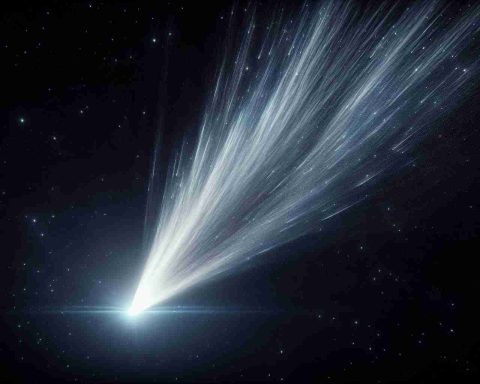- Comet ATLAS C/2024 G3 is expected to be the brightest comet of 2025, with its closest approach to the sun on January 13, 2025.
- The comet will pass just 8.3 million miles from the sun and may reach a brightness magnitude of -6.9, potentially visible in daylight.
- Viewing the comet during daylight can be dangerous, but it will be best seen after sunset in the Southern Hemisphere.
- This event is a prime opportunity for amateur astronomers and educational outreach in astronomy.
- Challenges in visibility, such as sunlight interference and cloud cover, may arise, but the potential spectacle is worth the effort.
Astrophotographers and skywatchers, prepare for a celestial showstopper! Comet ATLAS C/2024 G3 is hurtling toward the sun, poised to be the brightest comet of 2025. This stellar spectacle will reach its closest approach, known as perihelion, on January 13, 2025, gliding a mere 8.3 million miles from our star. Discovered by the Asteroid Terrestrial-impact Last Alert System (ATLAS) on April 5, 2024, this long-period comet arcs across the cosmos with an astounding orbital period of about 160,000 years.
Will it shine as bright as expected? Many astronomers are buzzing with excitement, speculating that it could blaze with a magnitude of -6.9. Imagine a comet so bright it could gleam even in daylight! Yet, viewing it during the day is hazardous due to its proximity to the sun. Southern Hemisphere dwellers will have the best seats in the house as the comet glows immediately after sunset, starting mid-January.
For amateur astronomers, this is the perfect chance to capture night sky magic. Educational initiatives in astronomy can use this opportunity to inspire a new generation of stargazers. While visibility might pose a challenge due to its close approach to the sun and potential cloud cover, the potential rewards are enormous.
As we edge closer to this stellar phenomenon, Comet ATLAS C/2024 G3 promises not just a brilliant display but a golden chance to rekindle our cosmic curiosity. Dust off your telescopes and gather your fellow space enthusiasts for a chance to witness one of nature’s rarest and most resplendent wonders.
Will Comet ATLAS C/2024 G3 Outshine Any Comet in Recent Memory? Discover What to Expect!
New, Relevant, and True Information About Comet ATLAS C/2024 G3
# Pros and Cons of Observing Comet ATLAS C/2024 G3
– Pros:
– Exceptional Brightness: The comet is expected to reach a magnitude of -6.9, potentially visible even during the day. This makes it a rare spectacle for both amateur and professional astronomers.
– Educational Opportunities: Provides a thrilling opportunity for educational programs in astronomy to engage students and the public.
– Unique Positioning: Best observed from the Southern Hemisphere, providing a unique vantage point and longer observation window.
– Cons:
– Daytime Hazards: Observing during daylight is not advisable due to its proximity to the sun, posing potential risks to eyesight.
– Weather Dependency: Cloud cover can obstruct visibility, and weather patterns are unpredictable.
– Narrow Observation Window: Being visible primarily post-sunset limits observation opportunities.
# Market Forecast and Trends in Astrophotography
– Increased Demand for Equipment: With celestial events on the rise, it’s anticipated that the astrophotography market will see increased sales in equipment like telescopes and camera gear.
– Trend Toward Digital Sharing: Enthusiasts are likely to leverage social media platforms to share their captures, driving a trend in digital content creation around astrophotography.
# Innovations and Predictions in Comet Research
– Advanced Observation Techniques: New technologies in telescopes and imaging are advancing our understanding of comets’ compositions and trajectories, providing deeper insights than ever before.
– Predictions: Comet ATLAS C/2024 G3 could become a benchmark for future comet observations, potentially influencing the development of new astronomical methods.
Top 3 Important Related Questions
# 1. How can amateur astronomers photograph Comet ATLAS C/2024 G3?
Amateur astronomers can enhance their chances by using a sturdy tripod to minimize vibration, employing a remote shutter release to reduce camera shake, and utilizing telescopic equipment with suitable focal lengths to capture the comet’s distinct features and tail. Additionally, researching the best software for post-processing can elevate the quality of their images.
# 2. What safety precautions should be taken while observing the comet?
Observers should avoid looking directly at the sun, especially during the day. Special solar filters or eclipse glasses should be used to protect the eyes if observing close to sunset. It’s also crucial to stay informed about local weather conditions and avoid observing during storms or cloudy conditions for optimal visibility.
# 3. What is the significance of Comet ATLAS C/2024 G3’s long orbital period?
The comet’s orbital period of about 160,000 years suggests it originated from the distant Oort Cloud, providing a rare glimpse into the early solar system’s conditions. Studying such long-period comets enhances our understanding of the solar system’s evolution and the origins of cometary bodies.
Suggested Related Links
– Nasa
– Sky & Telescope
– Astronomy

















